Physicochemical Properties of Diethyl Ether—Sunflower Oil Blends and Their Impact on Diesel Engine Emissions
Abstract
:1. Introduction
2. Selected Physicochemical Properties of Sunflower Oil
3. Materials and Methods
4. Results
4.1. Physicochemical Properties of Tested Fuels
4.2. Engine Emissions
5. Conclusions
Supplementary Materials
Author Contributions
Funding
Institutional Review Board Statement
Informed Consent Statement
Data Availability Statement
Conflicts of Interest
Abbreviations
| ASTM | American Society for Testing and Materials |
| CFPP | Cold filter plugging point |
| CP | Cloud point |
| CO | Carbon monoxide |
| CO2 | Carbon dioxide |
| DEE | Diethyl ether |
| DF | Diesel fuel |
| DI | Direct injection |
| FP | Flash point |
| HC | Hydrocarbon |
| TDC | Top Dead Center |
| THC | Total hydrocarbons |
| HFRR | High Frequency Reciprocating Rig |
| LHV | Lower heating value |
| N | Torque |
| NOX | Nitrogen oxides |
| PP | Pour point |
| SO | Sunflower oil |
| SO10 | Blend containing 10% DEE by vol. and 90% SO |
| SO20 | Blend containing 20% DEE by vol. and 80% SO |
| SO30 | Blend containing 30% DEE by vol. and 70% SO |
| SVO | Straight vegetable oil |
| ρ | Density |
| ν | Kinematic viscosity |
| σ | Surface tension |
| v/v | Volumetric ratio |
References
- Chong, C.T.; Loe, T.Y.; Wong, K.Y.; Ashokkumar, V.; Lam, S.S.; Chong, W.T.; Borrion, A.; Tian, B.; Ng, J.-H. Biodiesel Sustainability: The Global Impact of Potential Biodiesel Production on the Energy–Water–Food (EWF) Nexus. Environ. Technol. Innov. 2021, 22, 101408. [Google Scholar] [CrossRef]
- Brown, M.A.; Soni, A. Expert Perceptions of Enhancing Grid Resilience with Electric Vehicles in the United States. Energy Res. Soc. Sci. 2019, 57, 101241. [Google Scholar] [CrossRef]
- Brännström, H.; Kumar, H.; Alén, R. Current and Potential Biofuel Production from Plant Oils. Bioenergy Res. 2018, 11, 592–613. [Google Scholar] [CrossRef]
- Valeika, G.; Matijošius, J.; Górski, K.; Rimkus, A.; Smigins, R. A Study of Energy and Environmental Parameters of a Diesel Engine Running on Hydrogenated Vegetable Oil (HVO) with Addition of Biobutanol and Castor Oil. Energies 2021, 14, 3939. [Google Scholar] [CrossRef]
- Ballerini, D.; Jones, T.; Rupnow, J. Biofuels: Meeting the Energy and Environmental Challenges of the Transportation Sector; IFP énergies Nouvelles Publications: Paris, France, 2012; ISBN 978-2-7108-0983-8. [Google Scholar]
- Bereczky, A. Effect of the Use of Waste Vegetable Oil Based Biodiesel on The Landscape in Diesel Engines. Therm. Sci. 2017, 21, 567–579. [Google Scholar] [CrossRef]
- Abdullah, B.; Syed Muhammad, S.A.F.; Shokravi, Z.; Ismail, S.; Kassim, K.A.; Mahmood, A.N.; Aziz, M.M.A. Fourth Generation Biofuel: A Review on Risks and Mitigation Strategies. Renew. Sustain. Energy Rev. 2019, 107, 37–50. [Google Scholar] [CrossRef]
- Agarwal, A.K.; Gupta, J.G.; Dhar, A. Potential and Challenges for Large-Scale Application of Biodiesel in Automotive Sector. Prog. Energy Combust. Sci. 2017, 61, 113–149. [Google Scholar] [CrossRef]
- Pedretti, F.E.; Del Gatto, A.; Pieri, S.; Mangoni, L.; Ilari, A.; Mancini, M.; Feliciangeli, G.; Leoni, E.; Toscano, G.; Duca, D. Experimental Study to Support Local Sunflower Oil Chains: Production of Cold Pressed Oil in Central Italy. Agriculture 2019, 9, 231. [Google Scholar] [CrossRef] [Green Version]
- Oilseeds Harvest in the EU-27 Should Increase Slightly. Available online: https://www.tridge.com/news/oilseeds-harvest-in-the-eu-27-should-increase-slig (accessed on 7 January 2022).
- Report on Global Market Supply 2020/2021. Available online: https://www.ufop.de/files/7216/1649/5848/UFOP_SupplyReport_2020-2021__120321.pdf (accessed on 7 January 2022).
- European Commission; Joint Research Centre. Definition of Input Data to Assess GHG Default Emissions from Biofuels in EU Legislation: Version 1c July 2017. Appendix 1, Outcomes of Stakeholders Consultations; Publications Office: Luxembourg, 2017. [Google Scholar]
- Schultz, E.B. Fuels and Chemicals from Oilseeds: Technology and Policy Options; CRC Press: Boca Raton, FL, USA, 2019; 270p. [Google Scholar]
- Jones, S.; Peterson, C.L. Using Unmodified Vegetable Oils as a Diesel Fuel Extender—A Literature Review. Available online: http://journeytoforever.org/biofuel_library/idahovegoilslitreview.pdf (accessed on 7 January 2022).
- Tahir, A.R.; Lapp, H.M.; Buchanan, L.C. Sunflower oil as a fuel for compression ignition engines. In Proceedings of the International Conference on Plant and Vegetable Oils Fuels, Fargo, ND, USA, 2–4 August 1982; ASAE: St. Joseph, MI, USA, 1982. [Google Scholar]
- Ziejewski, M.; Kaufman, K.R. Endurance Test of a Sunflower Oil/Diesel Fuel Blend; SAE Technical Paper Series; SAE: Warrendale, PA, USA, 1982; p. 820257. [Google Scholar]
- German, T.J.; Kaufman, K.R.; Pratt, G.L.; Derry, J. Field Evaluation of Sunflower Oil/Diesel Fuel Blends in Diesel Engines; Paper Number 85-3078; ASAE: St. Joseph, MI, USA, 1985. [Google Scholar]
- Rakopoulos, D.C.; Rakopoulos, C.D.; Giakoumis, E.G.; Dimaratos, A.M.; Founti, M.A. Comparative Environmental Behavior of Bus Engine Operating on Blends of Diesel Fuel with Four Straight Vegetable Oils of Greek Origin: Sunflower, Cottonseed, Corn and Olive. Fuel 2011, 90, 3439–3446. [Google Scholar] [CrossRef]
- Arapatsakos, C.; Karkanis, A.; Cristoforidis, D.; Mitroulias, D.; Teka, C. Sunflower Oil as Fuel in a Diesel Engine; WIT Press: Malta, MT, USA, 2008; pp. 405–411. [Google Scholar] [CrossRef] [Green Version]
- Balafoutis, A.T.; Papageorgiou, E.; Dikopoulou, Z.; Fountas, S.; Papadakis, G. Sunflower Oil Fuel for Diesel Engines: An Experimental Investigation and Optimum Engine Setting Evaluation Using a Multi-Criteria Decision Making Approach. Int. J. Green Energy 2014, 11, 642–673. [Google Scholar] [CrossRef]
- Balafoutis, A.; Fountas, S.; Natsis, A.; Papadakis, G. Performance and Emissions of Sunflower, Rapeseed, and Cottonseed Oils as Fuels in an Agricultural Tractor Engine. ISRN Renew. Energy 2011, 2011, 531510. [Google Scholar] [CrossRef] [Green Version]
- Hemanandh, J.; Narayanan, K.V. Emission and Performance Analysis of Hydrotreated Refined Sunflower Oil as Alternate Fuel. Alex. Eng. J. 2015, 54, 389–393. [Google Scholar] [CrossRef] [Green Version]
- Pavani, A.; Hebale, A.; Poojary, V.; Parulekar, S.; Kiran, C.; Neeta, K. Waste Sunflower Oil as an Alternative Fuel for Diesel Engines. In Proceedings of the 2015 International Conference on Nascent Technologies in the Engineering Field (ICNTE), Navi Mumbai, India, 9–10 January 2015; IEEE: Navi Mumbai, India, 2015; pp. 1–6. [Google Scholar]
- Górski, K.; Smigins, R.; Longwic, R. Research on Physico-Chemical Properties of Diethyl Ether/Linseed Oil Blends for the Use as Fuel in Diesel Engines. Energies 2020, 13, 6564. [Google Scholar] [CrossRef]
- Ozsezen, A.N. Using Preheated Crude Sunflower Oil as a Fuel in a Diesel Engine. Energy Sources Part A Recovery Util. Environ. Eff. 2012, 34, 508–518. [Google Scholar] [CrossRef]
- Agarwal, D.; Agarwal, A.K. Performance and Emissions Characteristics of Jatropha Oil (Preheated and Blends) in a Direct Injection Compression Ignition Engine. Appl. Therm. Eng. 2007, 27, 2314–2323. [Google Scholar] [CrossRef]
- Tomic, M.; Savin, L.; Micic, R.; Simikic, M.; Furman, T. Possibility of Using Biodiesel from Sunflower Oil as an Additive for the Improvement of Lubrication Properties of Low-Sulfur Diesel Fuel. Energy 2014, 65, 101–108. [Google Scholar] [CrossRef]
- Sidibé, S.S.; Blin, J.; Vaitilingom, G.; Azoumah, Y. Use of Crude Filtered Vegetable Oil as a Fuel in Diesel Engines State of the Art: Literature Review. Renew. Sustain. Energy Rev. 2010, 14, 2748–2759. [Google Scholar] [CrossRef]
- Šmigins, R. Perspectives of low level ethanol and biodiesel/diesel fuel blends on diesel engine emission reduction. In Proceedings of the 20th International Scientific Conference, Juodkrante, Lithuania, 5–6 October 2016; pp. 337–341. [Google Scholar]
- Bailey, B.; Eberhardt, J.; Goguen, S.; Erwin, J. Diethyl ether (DEE) as a renewable diesel fuel. SAE Trans. 1997, 106, 1578–1584. [Google Scholar]
- Ibrahim, A. Investigating the Effect of Using Diethyl Ether as a Fuel Additive on Diesel Engine Performance and Combustion. Appl. Therm. Eng. 2016, 107, 853–862. [Google Scholar] [CrossRef]
- Sivalakshmi, S.; Balusamy, T. Effect of Biodiesel and Its Blends with Diethyl Ether on the Combustion, Performance and Emissions from a Diesel Engine. Fuel 2013, 106, 106–110. [Google Scholar] [CrossRef]
- Ibrahim, A. An Experimental Study on Using Diethyl Ether in a Diesel Engine Operated with Diesel-Biodiesel Fuel Blend. Eng. Sci. Technol. Int. J. 2018, 21, 1024–1033. [Google Scholar] [CrossRef]
- Górski, K.; Smigins, R. Selected physicochemical properties of diethyl ether/rapeseed oil blends and their impact on diesel engine smoke opacity. Energy Fuels 2018, 32, 1796–1803. [Google Scholar] [CrossRef]
- Krishnamoorthi, M.; Malayalamurthi, R. Experimental investigation on the availability, performance, combustion and emission distinctiveness of bael oil/diesel/diethyl ether blends powered in a variable compression ratio diesel engine. Heat Mass Transf. 2018, 54, 2023–2044. [Google Scholar] [CrossRef]
- Patil, K.; Thipse, S. Experimental investigation of CI engine combustion, performance and emissions in DEE–kerosene–diesel blends of high DEE concentration. Energy Convers. Manag. 2015, 89, 396–408. [Google Scholar] [CrossRef]
- Aguado-Deblas, L.; Hidalgo-Carrillo, J.; Bautista, F.M.; Luna, D.; Luna, C.; Calero, J.; Posadillo, A.; Romero, A.A.; Estevez, R. Diethyl Ether as an Oxygenated Additive for Fossil Diesel/Vegetable Oil Blends: Evaluation of Performance and Emission Quality of Triple Blends on a Diesel Engine. Energies 2020, 13, 1542. [Google Scholar] [CrossRef] [Green Version]
- Dinesha, P.; Kumar, S.; Rosen, M.A. Combined Effects of Water Emulsion and Diethyl Ether Additive on Combustion Performance and Emissions of a Compression Ignition Engine Using Biodiesel Blends. Energy 2019, 179, 928–937. [Google Scholar] [CrossRef]
- EL-Seesy, A.I.; Waly, M.S.; He, Z.; El-Batsh, H.M.; Nasser, A.; El-Zoheiry, R.M. Influence of Quaternary Combinations of Biodiesel/Methanol/n-Octanol/Diethyl Ether from Waste Cooking Oil on Combustion, Emission, and Stability Aspects of a Diesel Engine. Energy Convers. Manag. 2021, 240, 114268. [Google Scholar] [CrossRef]
- Smigins, R.; Zakis, A. Impact of Diethyl Ether/Rapeseed Oil Blends on Performance and Emissions of a Light-Duty Diesel Vehicle. Energies 2020, 13, 3788. [Google Scholar] [CrossRef]
- Kumar, A.; Rajan, K.; Rajaram Naraynan, M.; Senthil Kumar, K. Performance and emission characteristics of a DI diesel engine fuelled with Cashew Nut Shell Oil (CNSO)-diesel blends with Diethyl ether as additive. Appl. Mech. Mater. 2015, 787, 746–750. [Google Scholar]
- Giakoumis, E.G. Analysis of 22 Vegetable Oils’ Physico-Chemical Properties and Fatty Acid Composition on a Statistical Basis, and Correlation with the Degree of Unsaturation. Renew. Energy 2018, 126, 403–419. [Google Scholar] [CrossRef]
- Goering, C.E.; Schwab, A.W.; Daugherty, M.J.; Pryde, E.H.; Heakin, A.J. Fuel Properties of Eleven Vegetable Oils. Trans. ASAE 1982, 25, 1472–1477. [Google Scholar] [CrossRef]
- Plank, M.; Wachtmeister, G.; Thuneke, K.; Remmele, E.; Emberger, P. Effect of Fatty Acid Composition on Ignition Behavior of Straight Vegetable Oils Measured in a Constant Volume Combustion Chamber Apparatus. Fuel 2017, 207, 293–301. [Google Scholar] [CrossRef]
- Esteban, B.; Riba, J.-R.; Baquero, G.; Rius, A.; Puig, R. Temperature Dependence of Density and Viscosity of Vegetable Oils. Biomass Bioenergy 2012, 42, 164–171. [Google Scholar] [CrossRef] [Green Version]
- Esteban, B.; Riba, J.-R.; Baquero, G.; Puig, R.; Rius, A. Characterization of the Surface Tension of Vegetable Oils to Be Used as Fuel in Diesel Engines. Fuel 2012, 102, 231–238. [Google Scholar] [CrossRef]
- Hossain, A.K.; Davies, P.A. Plant Oils as Fuels for Compression Ignition Engines: A Technical Review and Life-Cycle Analysis. Renew. Energy 2010, 35, 1–13. [Google Scholar] [CrossRef]
- Selim, M.Y.E. Reducing the Viscosity of Jojoba Methyl Ester Diesel Fuel and Effects on Diesel Engine Performance and Roughness. Energy Convers. Manag. 2009, 50, 1781–1788. [Google Scholar] [CrossRef]
- Ghurri, A.; Kim, J.-D.; Kim, H.G.; Jung, J.-Y.; Song, K.-K. The Effect of Injection Pressure and Fuel Viscosity on the Spray Characteristics of Biodiesel Blends Injected into an Atmospheric Chamber. J. Mech. Sci. Technol. 2012, 26, 2941–2947. [Google Scholar] [CrossRef]
- Demonstration of 2nd Generation Vegetable Oil Fuels in Advanced Engines|2NDVEGOIL Project|Fact Sheet|FP7|CORDIS|European Commission. Available online: https://cordis.europa.eu/project/id/219004 (accessed on 7 January 2022).
- No, S.-Y. Application of Straight Vegetable Oil from Triglyceride Based Biomass to IC Engines—A Review. Renew. Sustain. Energy Rev. 2017, 69, 80–97. [Google Scholar] [CrossRef]
- Chhetri, A.B.; Watts, K.C. Surface Tensions of Petro-Diesel, Canola, Jatropha and Soapnut Biodiesel Fuels at Elevated Temperatures and Pressures. Fuel 2013, 104, 704–710. [Google Scholar] [CrossRef]
- Park, J.-Y.; Kim, D.-K.; Lee, J.-P.; Park, S.-C.; Kim, Y.-J.; Lee, J.-S. Blending Effects of Biodiesels on Oxidation Stability and Low Temperature Flow Properties. Bioresour. Technol. 2008, 99, 1196–1203. [Google Scholar] [CrossRef] [PubMed]
- Vijayan, S.K.; Naveena Victor, M.; Sudharsanam, A.; Chinnaraj, V.K.; Nagarajan, V. Winterization Studies of Different Vegetable Oil Biodiesel. Bioresour. Technol. Rep. 2018, 1, 50–55. [Google Scholar] [CrossRef]
- Mehta, P.S.; Anand, K. Estimation of a Lower Heating Value of Vegetable Oil and Biodiesel Fuel. Energy Fuels 2009, 23, 3893–3898. [Google Scholar] [CrossRef]
- Pinzi, S.; Leiva, D.; Arzamendi, G.; Gandia, L.M.; Dorado, M.P. Multiple Response Optimization of Vegetable Oils Fatty Acid Composition to Improve Biodiesel Physical Properties. Bioresour. Technol. 2011, 102, 7280–7288. [Google Scholar] [CrossRef]
- Efe, Ş.; Ceviz, M.A.; Temur, H. Comparative Engine Characteristics of Biodiesels from Hazelnut, Corn, Soybean, Canola and Sunflower Oils on DI Diesel Engine. Renew. Energy 2018, 119, 142–151. [Google Scholar] [CrossRef]
- Jiang, Z.; Lu, X.; Geng, S.; Ma, H.; Liu, B. Structuring of Sunflower Oil by Stearic Acid Derivatives: Experimental and Molecular Modelling Studies. Food Chem. 2020, 324, 126801. [Google Scholar] [CrossRef] [PubMed]
- Ileri, E. Experimental Study of 2-Ethylhexyl Nitrate Effects on Engine Performance and Exhaust Emissions of a Diesel Engine Fueled with n-Butanol or 1-Pentanol Diesel–Sunflower Oil Blends. Energy Convers. Manag. 2016, 118, 320–330. [Google Scholar] [CrossRef]
- Zhang, L.; Tang, W.; Dong, C.; Zhou, D.; Xing, X.; Dong, W.; Ding, Y.; Wang, G.; Wu, M. Bionic Sunflower-like Structure of Polydopamine-Confined NiFe-Based Quantum Dots for Electrocatalytic Oxygen Evolution Reaction. Appl. Catal. B Environ. 2022, 302, 120833. [Google Scholar] [CrossRef]
- Vergel-Ortega, M.; Valencia-Ochoa, G.; Duarte-Forero, J. Experimental Study of Emissions in Single-Cylinder Diesel Engine Operating with Diesel-Biodiesel Blends of Palm Oil-Sunflower Oil and Ethanol. Case Stud. Therm. Eng. 2021, 26, 101190. [Google Scholar] [CrossRef]
- Elkelawy, M.; Alm-Eldin Bastawissi, H.; Esmaeil, K.K.; Radwan, A.M.; Panchal, H.; Sadasivuni, K.K.; Ponnamma, D.; Walvekar, R. Experimental Studies on the Biodiesel Production Parameters Optimization of Sunflower and Soybean Oil Mixture and DI Engine Combustion, Performance, and Emission Analysis Fueled with Diesel/Biodiesel Blends. Fuel 2019, 255, 115791. [Google Scholar] [CrossRef]
- Ghanei, R.; Moradi, G.R.; Taherpour Kalantari, R.; Arjmandzadeh, E. Variation of Physical Properties during Transesterification of Sunflower Oil to Biodiesel as an Approach to Predict Reaction Progress. Fuel Process. Technol. 2011, 92, 1593–1598. [Google Scholar] [CrossRef]
- Chong, C.T.; Chiong, M.-C.; Ng, J.-H.; Lim, M.; Tran, M.-V.; Valera-Medina, A.; Chong, W.W.F. Oxygenated Sunflower Biodiesel: Spectroscopic and Emissions Quantification under Reacting Swirl Spray Conditions. Energy 2019, 178, 804–813. [Google Scholar] [CrossRef]
- Hazrat, M.A.; Rasul, M.G.; Khan, M.M.K.; Ashwath, N.; Rufford, T.E. Emission Characteristics of Polymer Additive Mixed Diesel-Sunflower Biodiesel Fuel. Energy Procedia 2019, 156, 59–64. [Google Scholar] [CrossRef]
- Keisham, M.; Jain, P.; Singh, N.; von Toerne, C.; Bhatla, S.C.; Lindermayr, C. Deciphering the Nitric Oxide, Cyanide and Iron-Mediated Actions of Sodium Nitroprusside in Cotyledons of Salt Stressed Sunflower Seedlings. Nitric Oxide 2019, 88, 10–26. [Google Scholar] [CrossRef]
- Canakci, M.; Ozsezen, A.N.; Turkcan, A. Combustion Analysis of Preheated Crude Sunflower Oil in an IDI Diesel Engine. Biomass Bioenergy 2009, 33, 760–767. [Google Scholar] [CrossRef]
- Rakopoulos, D.C. Heat Release Analysis of Combustion in Heavy-Duty Turbocharged Diesel Engine Operating on Blends of Diesel Fuel with Cottonseed or Sunflower Oils and Their Bio-Diesel. Fuel 2012, 96, 524–534. [Google Scholar] [CrossRef]
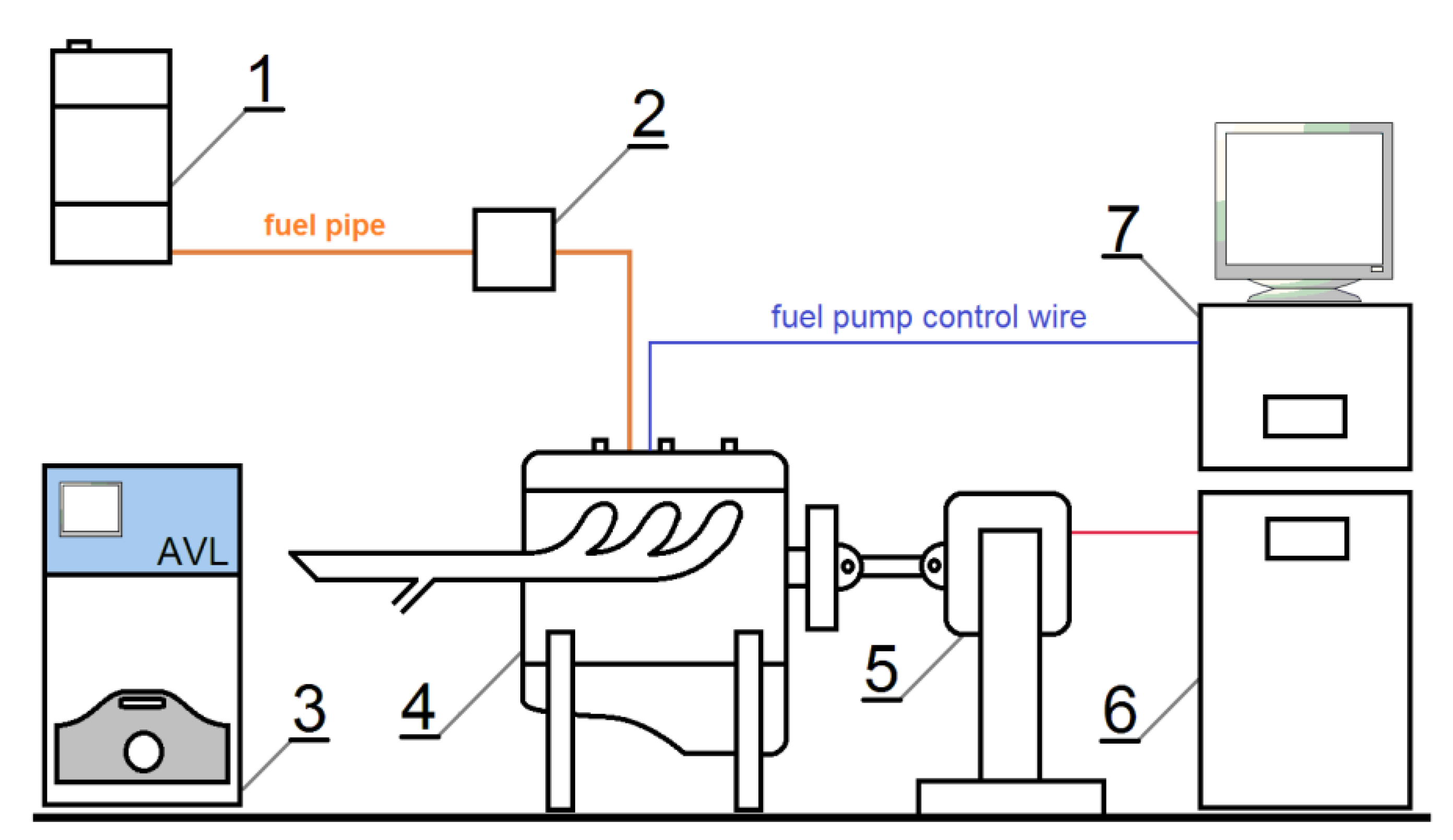


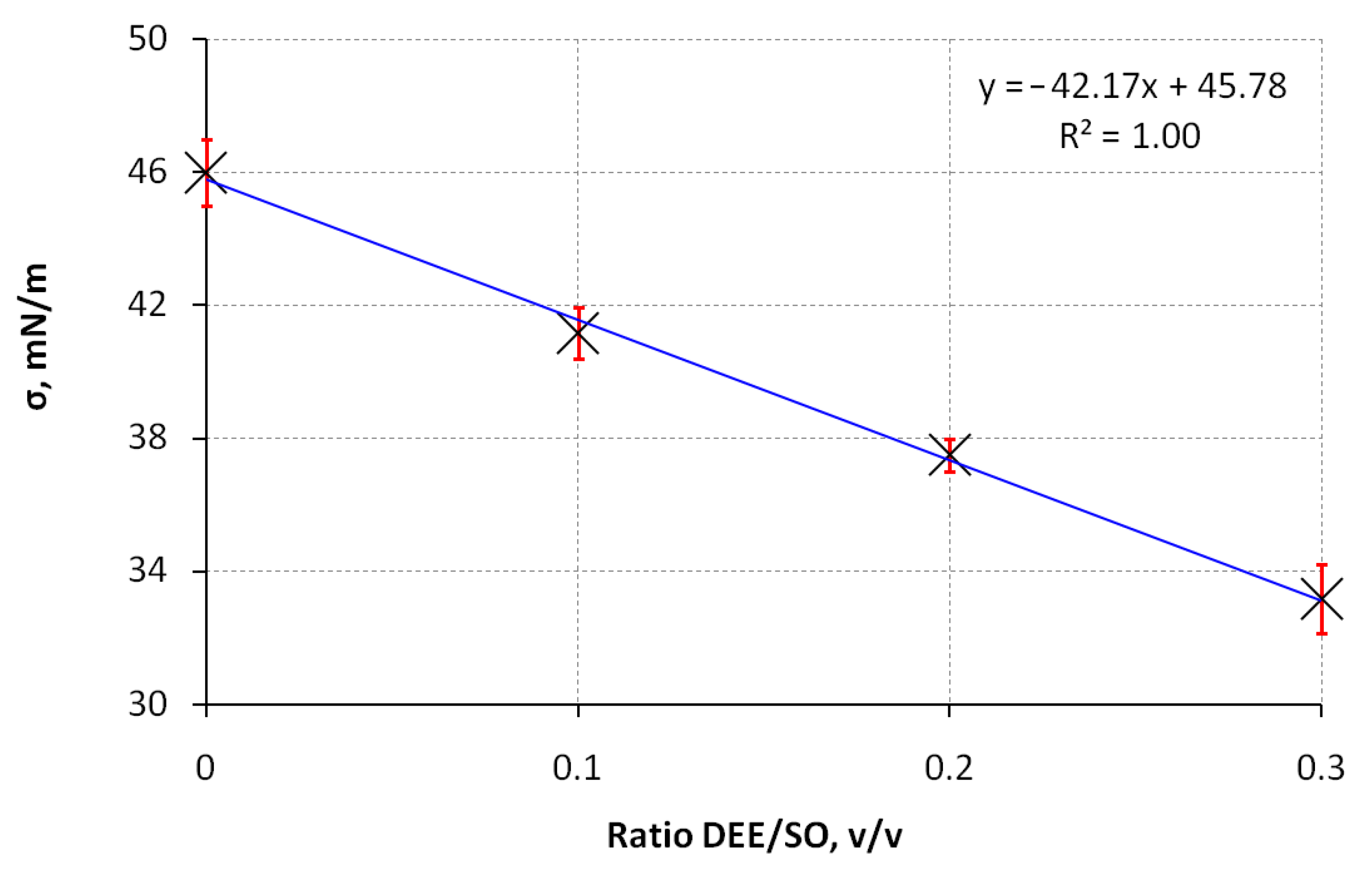
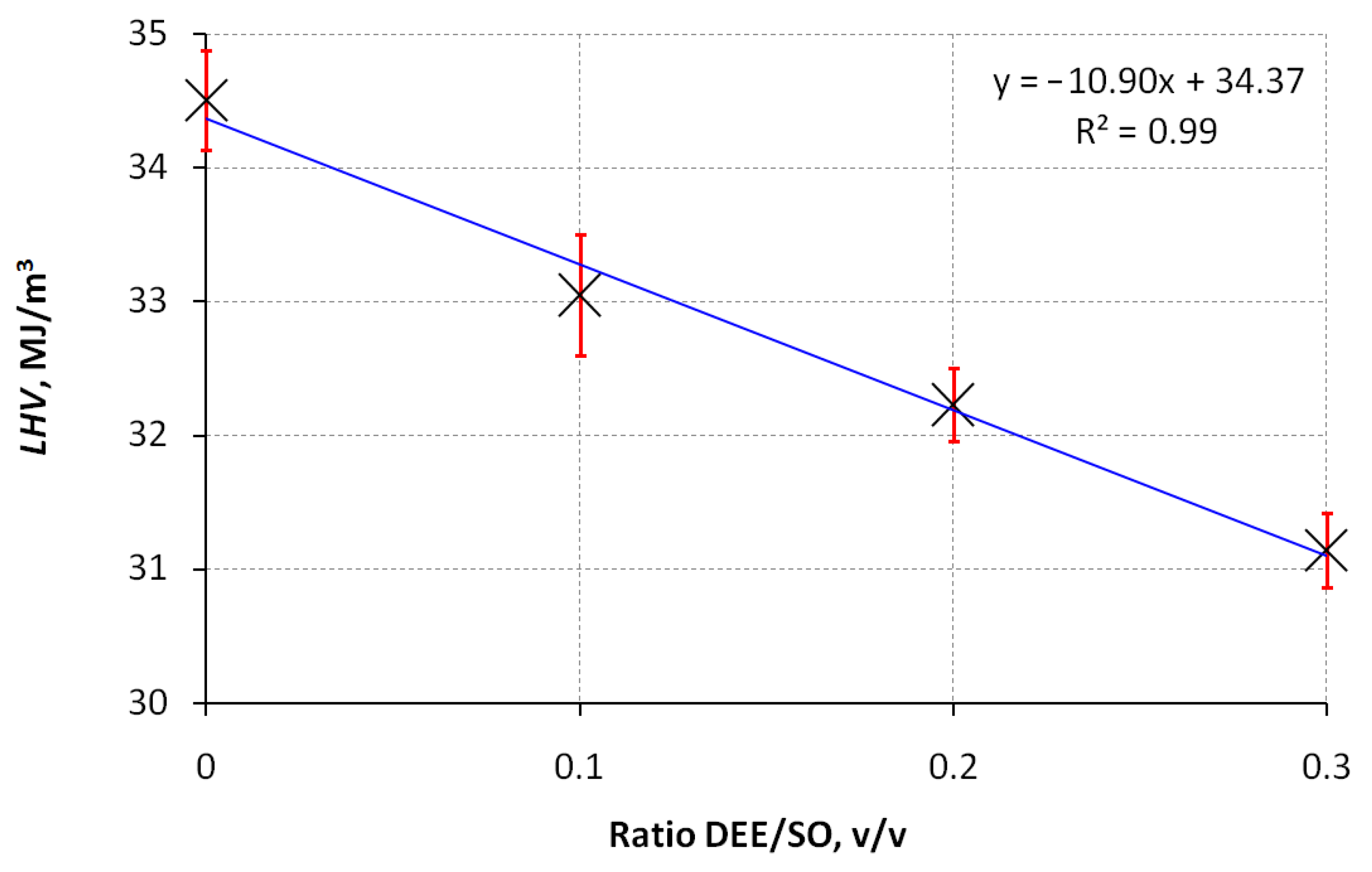
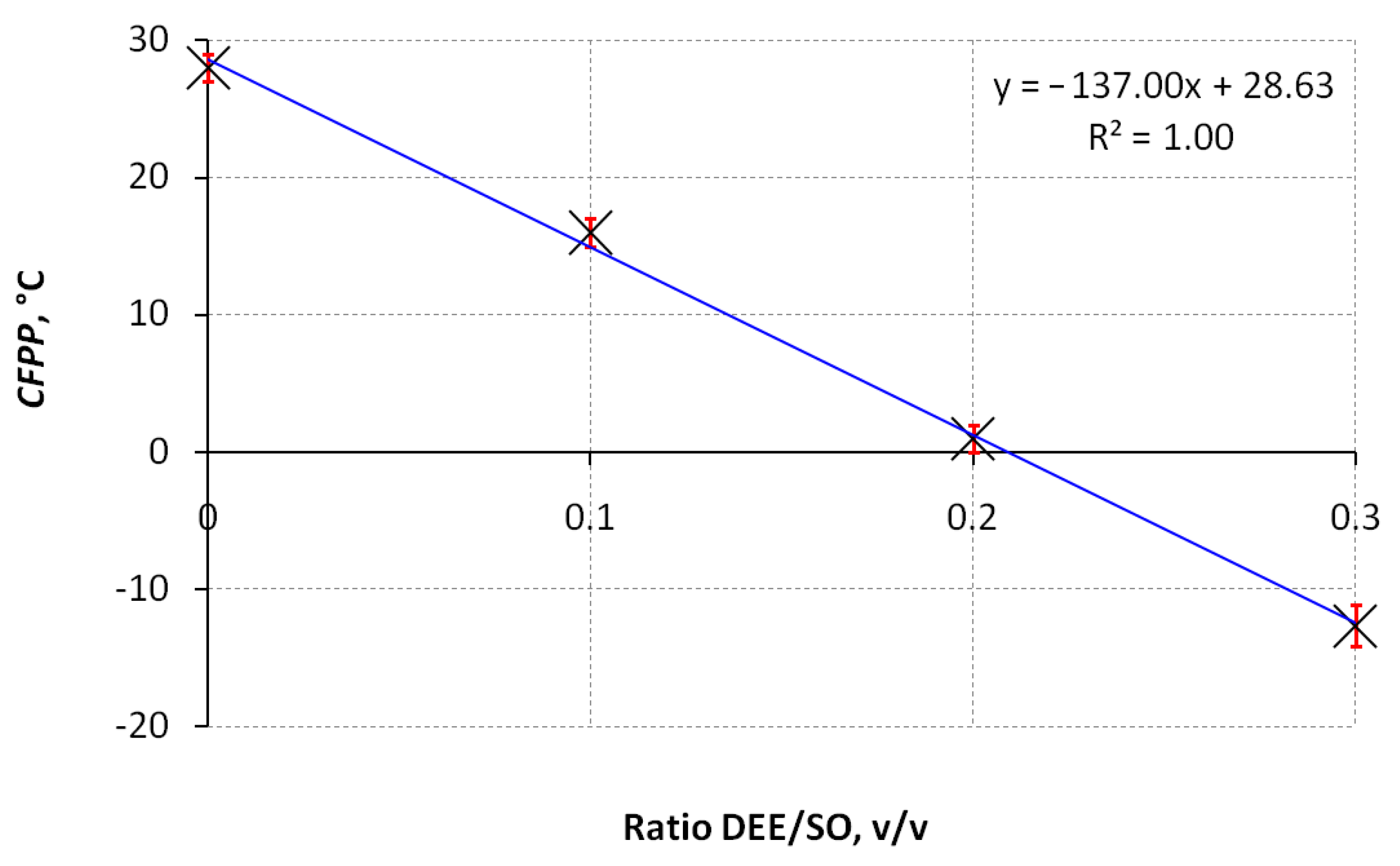
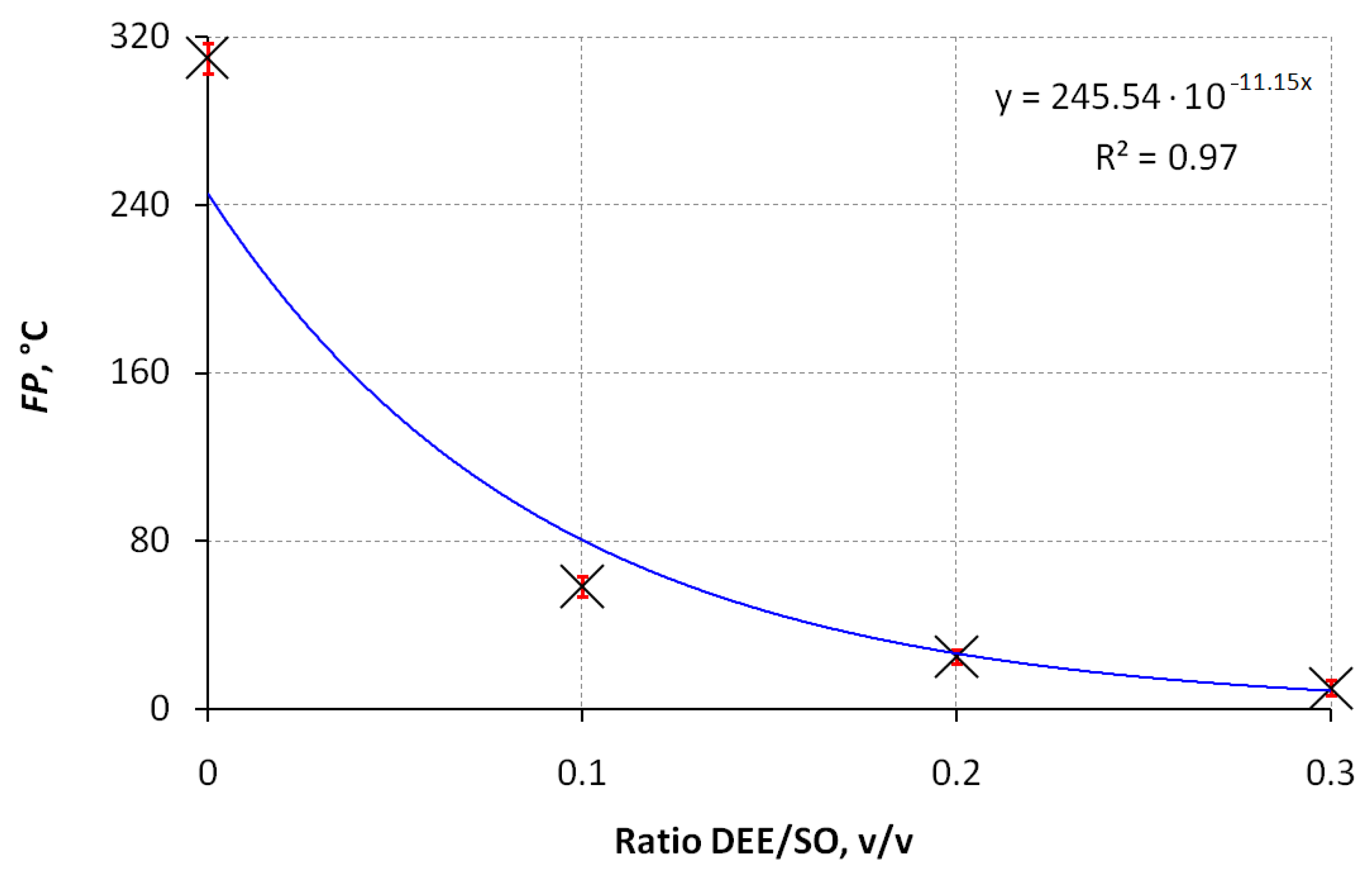
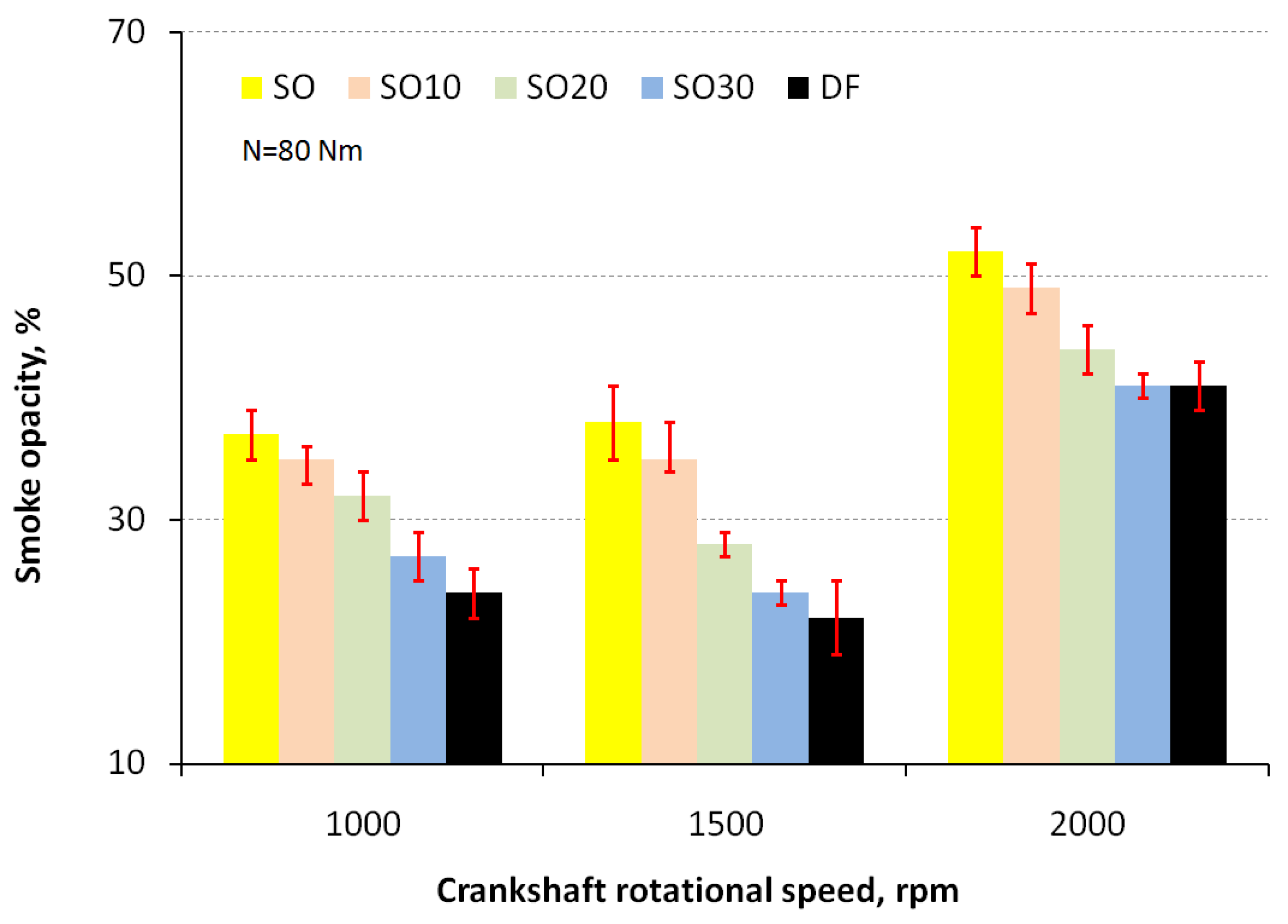
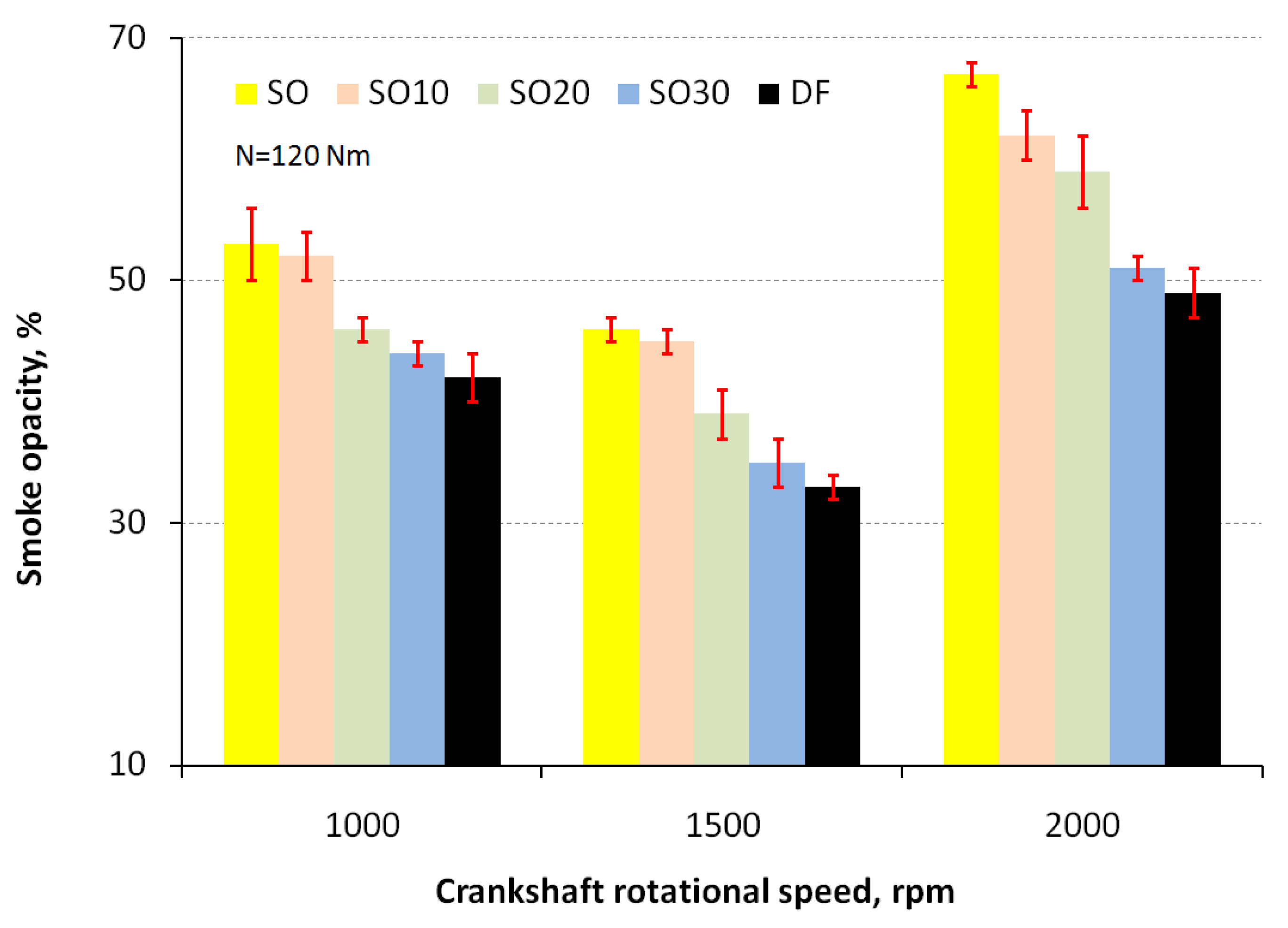
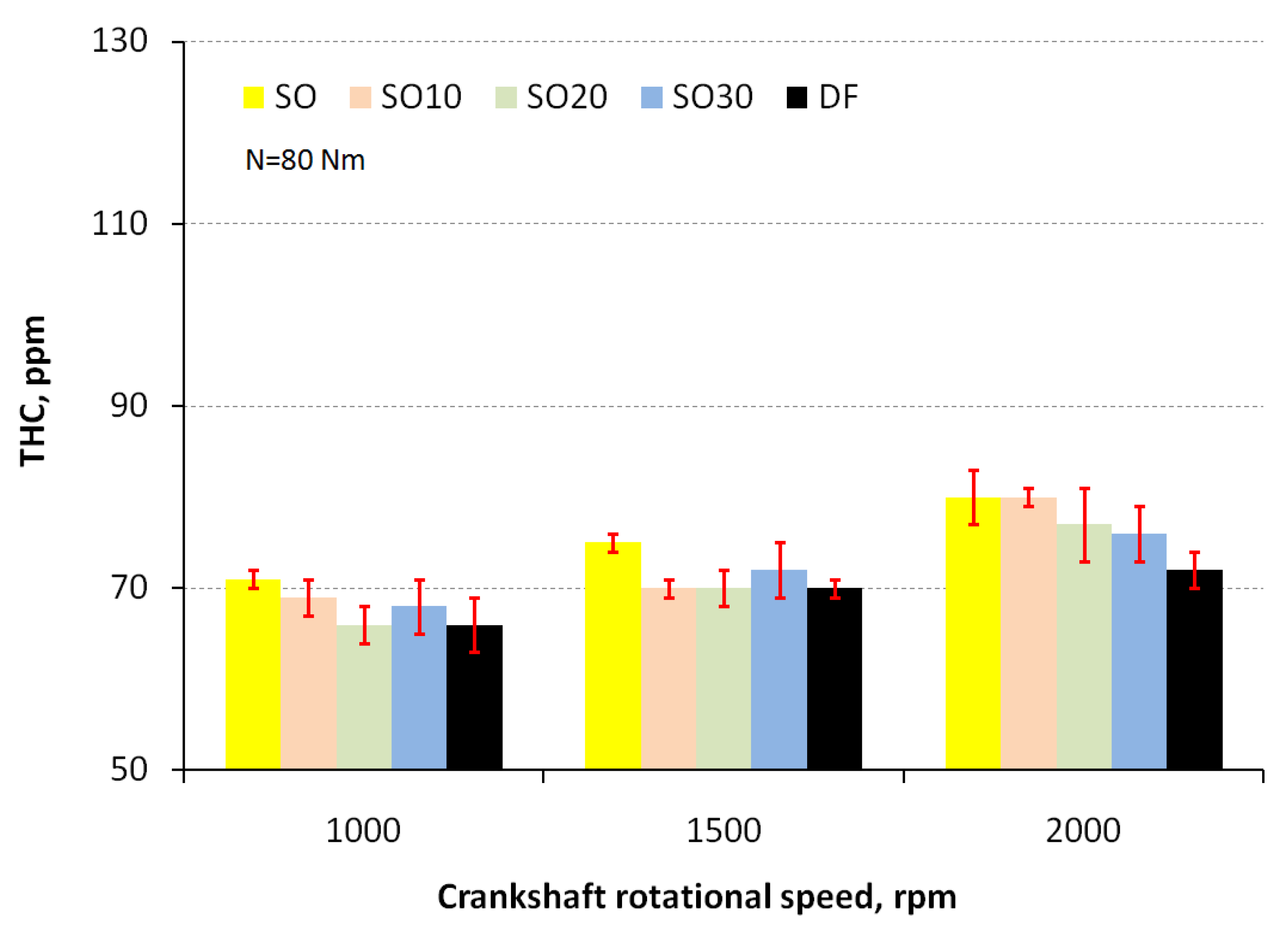

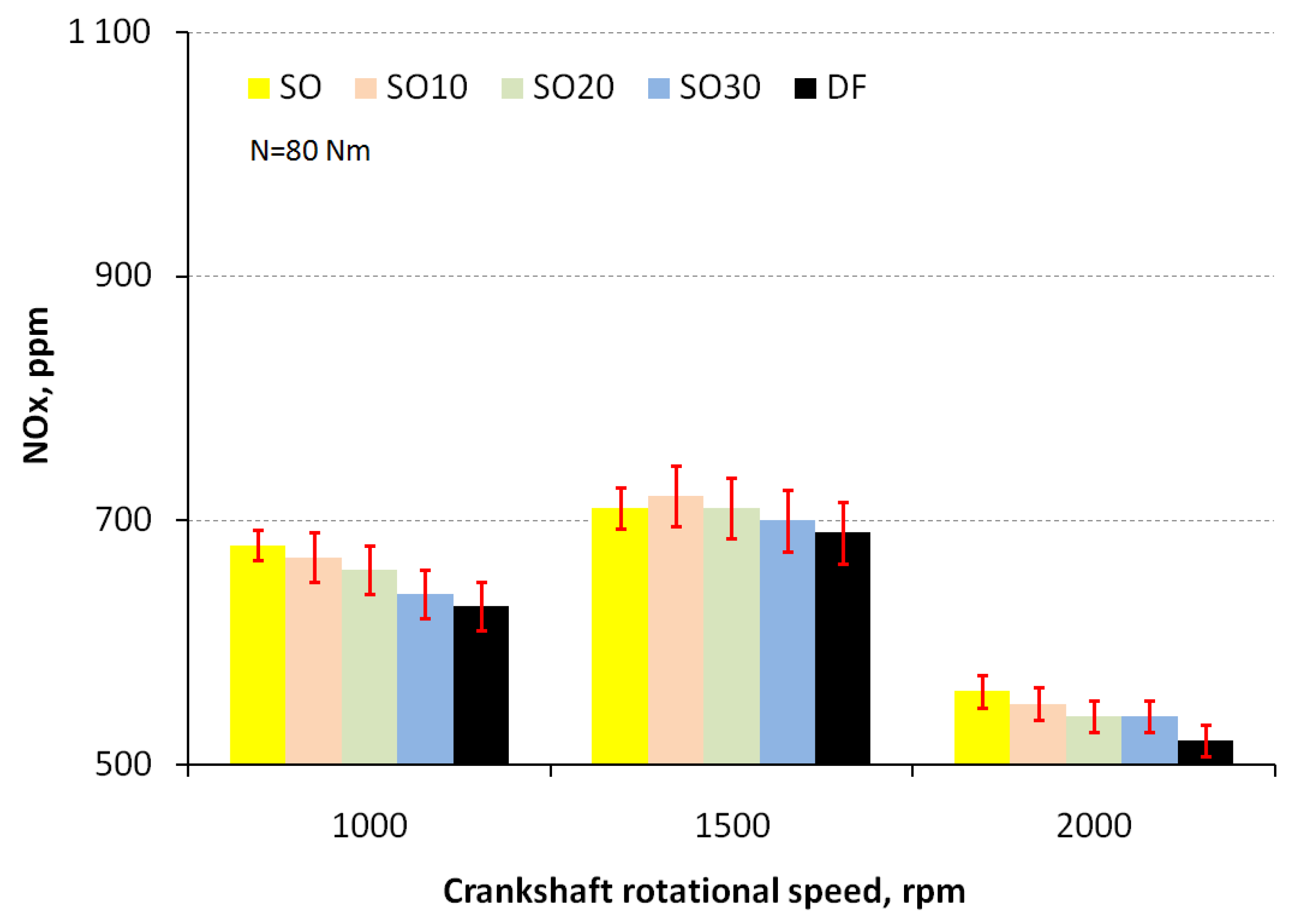
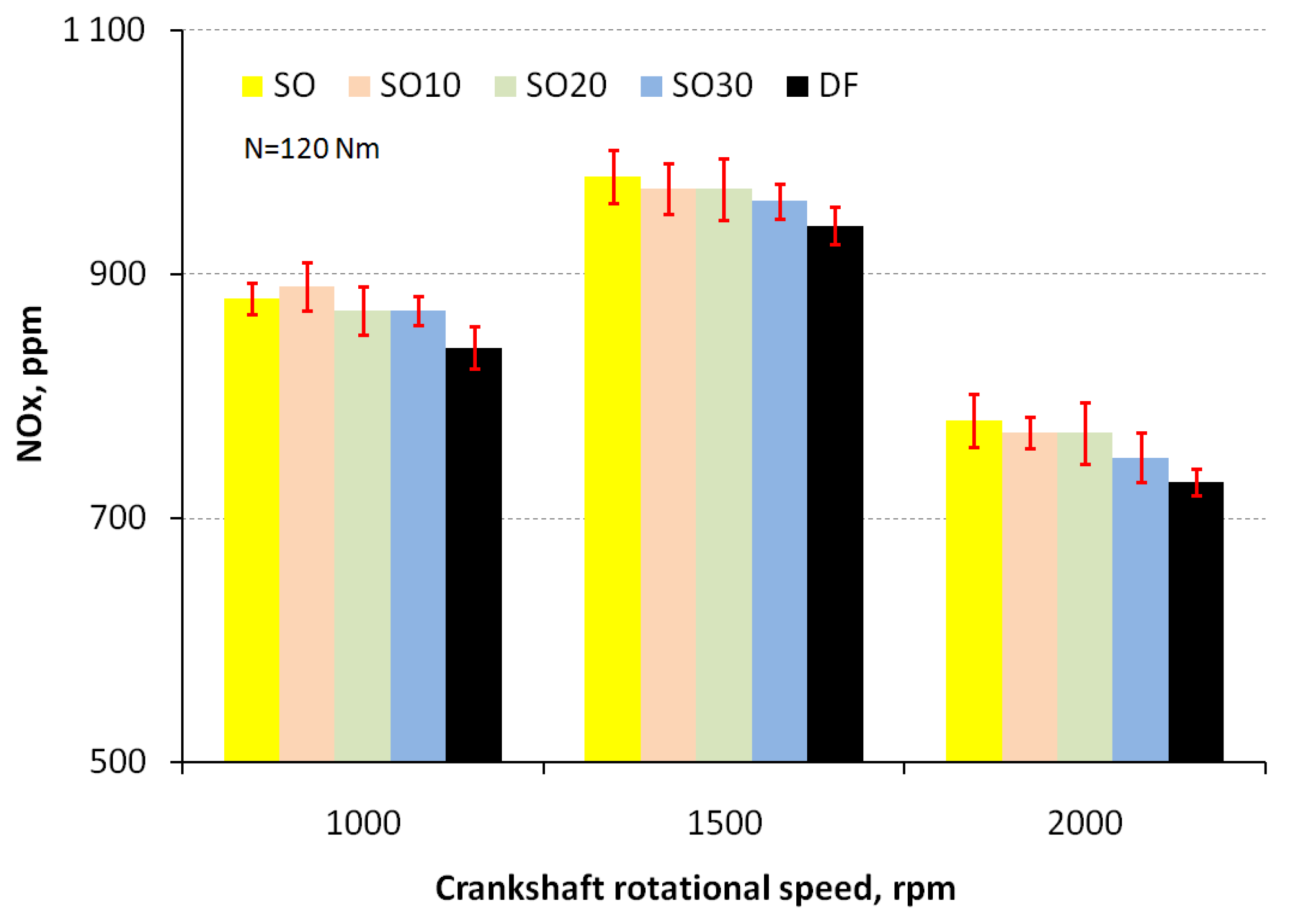
| Property | Method | Fuel | ||
|---|---|---|---|---|
| SO | DEE | DF | ||
| Density at 15 °C, g/cm3 | ISO 12185:1996 | 0.919 | 0.710 | 0.832 |
| Viscosity at 40 °C, mm2/s | ASTM D7042 | 34.50 | 0.23 | 3.45 |
| LHV, MJ/kg | ASTM D240-02:2007 | 37.2 | 33.8 | 43.9 |
| Surface tension, mN/m | ISO 304:1985 | 46.0 | 16.8 | 32.1 |
| CFPP, °C | EN 116:1997 | 28.0 | - a | 3.0 |
| FP, °C | PN-EN 2719 | 310 | −40 | 60 |
| HFRR, μm | ASTM D6079-18 | 180 | - b | 370 |
| Cetane number | - | 37 | 125 c | 51 |
| Parameter | Value |
|---|---|
| Engine capacity | 2502 cm3 |
| Cylinder number | 3, in line |
| Top power | 34.6 kW at 2150 rpm |
| Maximum torque | 145 Nm at 1200–1400 rpm |
| Compression ratio | 16.5 |
| Fuel injection pressure | 17 MPa |
| Crankshaft speed at idle run | 750 rpm |
| Fuel injection system | Lucas—CAV type DPA |
| Start of injection | 17° before TDC |
| Parameter | Measurement Range | Accuracy |
|---|---|---|
| NOX | 0–5000 ppm vol. | 1 ppm |
| HC | 0–20,000 ppm vol. | 1 ppm |
| CO | 0–10% vol. | 0.01% vol |
| Smoke opacity | 0–100% | 0.1% |
Publisher’s Note: MDPI stays neutral with regard to jurisdictional claims in published maps and institutional affiliations. |
© 2022 by the authors. Licensee MDPI, Basel, Switzerland. This article is an open access article distributed under the terms and conditions of the Creative Commons Attribution (CC BY) license (https://creativecommons.org/licenses/by/4.0/).
Share and Cite
Górski, K.; Smigins, R.; Matijošius, J.; Rimkus, A.; Longwic, R. Physicochemical Properties of Diethyl Ether—Sunflower Oil Blends and Their Impact on Diesel Engine Emissions. Energies 2022, 15, 4133. https://doi.org/10.3390/en15114133
Górski K, Smigins R, Matijošius J, Rimkus A, Longwic R. Physicochemical Properties of Diethyl Ether—Sunflower Oil Blends and Their Impact on Diesel Engine Emissions. Energies. 2022; 15(11):4133. https://doi.org/10.3390/en15114133
Chicago/Turabian StyleGórski, Krzysztof, Ruslans Smigins, Jonas Matijošius, Alfredas Rimkus, and Rafał Longwic. 2022. "Physicochemical Properties of Diethyl Ether—Sunflower Oil Blends and Their Impact on Diesel Engine Emissions" Energies 15, no. 11: 4133. https://doi.org/10.3390/en15114133
APA StyleGórski, K., Smigins, R., Matijošius, J., Rimkus, A., & Longwic, R. (2022). Physicochemical Properties of Diethyl Ether—Sunflower Oil Blends and Their Impact on Diesel Engine Emissions. Energies, 15(11), 4133. https://doi.org/10.3390/en15114133








